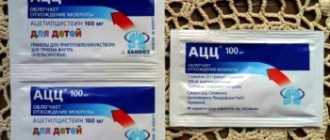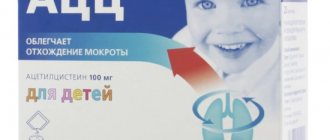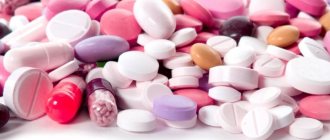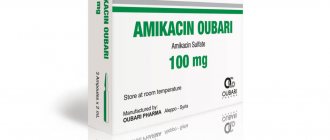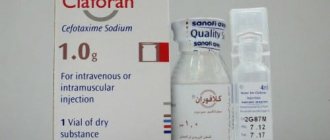pharmachologic effect
Has a wide spectrum of antibacterial activity. Suppresses the growth of the microbial cell wall, causing its death.
Ampicillin activity:
- aerobic gram-positive bacteria: staphylococci (not producing the enzyme penicillinase), streptococci, enterococci, listeria;
- gram-negative aerobes: Escherichia coli, Neisseria, Salmonella, pertussis, some types of Haemophilus influenzae.
Ampicillin is destroyed by β-lactamases and penicillinases produced by drug-resistant bacteria.
Injection allows Ampicillin to circulate in the blood in high concentrations, penetrate into tissues, through the placenta to the fetus, into breast milk, and during inflammation into the brain. The concentration in bile is higher than in the blood.
Metabolism occurs in the liver. Part of the drug (70%) is excreted unchanged in urine and bile. If kidney function is impaired, the content of ampicillin in the blood increases, and therefore excretion occurs more slowly.
Contraindications
Contraindications to the use of Ampicillin are:
- individual intolerance to drugs of the penicillin group and other β-lactam antibacterial agents (carbapenems and cephalosporins);
- severe functional disorders of the liver;
- severe functional impairment of the kidneys;
- diseases of the digestive system, including colitis that occurs while taking antibacterial agents;
- leukemia;
- Infectious mononucleosis;
- HIV infection;
- breastfeeding period.
Indications
Various types of bacterial infections:
- respiratory tract, middle ear (otitis, pharyngitis, sinusitis, bronchitis, pneumonia, pulmonary abscess);
- genitourinary system (cystitis, urethritis, pyelitis, pyelonephritis, gonorrhea);
- in the biliary tract (cholecystitis, cholangitis);
- typhoid fever;
- whooping cough
- scarlet fever;
- sepsis;
- peritonitis;
- meningitis;
- endocarditis;
- listeriosis;
- infectious lesions of the musculoskeletal system (rheumatism);
- dermatological lesions (erysipelas).
Compatibility with other drugs
When prescribing an antibiotic, its interaction with other pharmacological drugs is taken into account:
- bacteriostatic agents (tetracyclines, macrolides, sulfonamides, lincosamides) lead to loss of ampicillin effectiveness,
- antibiotics from the groups of aminoglycosides and cephalosporins enhance the effect of the substance to the point of toxicity, causing adverse reactions,
- means for normalizing the acid balance of the stomach and activating intestinal motility slow down the absorption of the active substance, as does taking ampicillin after meals,
- ascorbic acid accelerates the absorption of the drug,
- the antibiotic reduces the effectiveness of contraceptives with estrogens, but enhances the effect of anticoagulants,
- diuretics (Allopurinol, Phenylbutazone, etc.), NSAIDs increase the concentration of ampicillin in the blood due to a decrease in tubular secretion,
- together with the xanthine oxidase inhibitor ampicillin leads to the appearance of urticaria and other skin reactions,
- the antibiotic increases the concentration of Digoxin and the toxicity of Methotrexate.
Ampicillin and alcohol cannot be combined. The instructions indicate possible risks associated with side effects, intoxication and a decrease in the effectiveness of antibacterial therapy.
Directions for use and doses
The instructions for use of Ampicillin solution warn that the powder must be diluted in a sufficient volume of the appropriate solvent. After dissolution, the medicine is administered intravenously or intramuscularly.
Intravenously
Instructions for adults: 0.25 - 0.5 g (every 4-6 hours), per day from 1 to 14 g maximum.
Instructions for newborns: an injection of 100 mg per 1 kg of body weight is administered per day. For older children, injections of the drug are given daily at a dose of 50 mg per 1 kg of body weight. In severe cases, doses are doubled.
To prepare an injection solution, you need to dilute 0.5 g of powder in 5 ml of liquid in the bottle itself, 1 g in 10 ml (water for injection or 0.9% sodium chloride). The prepared solution should be administered very slowly (up to 5 minutes) in order to avoid convulsive contractions. It is not forbidden to prepare a solution with 5% glucose.
The powder should be dissolved in liquid only before administration; the daily dose is divided into 3-4 injections. The duration is determined by the doctor individually.
Intramuscularly
To relieve pain when injected into a muscle, dilution can be carried out with novocaine. If a dose is missed, do not double the dose.
special instructions
During treatment with Ampicillin, it is important to take into account the following points:
- before starting treatment, it is necessary to exclude an allergic reaction to ampicillin;
- It is strictly forbidden to mix the prepared injection solution with other drugs;
- during the treatment course, strict monitoring of peripheral blood composition, renal and hepatic functions should be carried out;
- for patients with impaired renal function, the daily dosage should be adjusted by reducing the single dose or increasing the time intervals between injections;
- for concomitant allergic pathologies (hay fever, asthmatic bronchial disease and others), Ampicillin is prescribed in combination with desensitizing drugs;
- Ampicillin does not affect the speed of motor and mental reactions, the ability to control transport and other mechanisms; however, some patients may develop side effects of Ampicillin on the central nervous system, so the drug should be taken with caution by people who require focus and concentration when working with dangerous mechanisms;
- when treated with Ampicillin with the simultaneous use of anticoagulants and aminoglycoside antibiotics, their therapeutic effect is enhanced;
- Ampicillin reduces the therapeutic effect of oral contraceptives;
- the toxic effect of Ampicillin increases when used simultaneously with probenecid;
- the combination of Ampicillin with allopurinol increases the risk of developing an allergic reaction manifested by a skin rash;
- simultaneous use of ampicillin with β-blockers increases the risk of developing anaphylactic shock;
- Ampicillin is incompatible with chloramphenicol, clindamycin, tetracycline, amphotercine, erythromycin, lincomycin, polymyxin B, metronidazole, acetylcysteine, metoclopramide, dopamine, heparin;
- long-term or repeated treatment with Ampicillin can cause the development and growth of resistant flora that is resistant to the action of the antibacterial agent;
- Ampicillin is excreted into breast milk, so breastfeeding should be discontinued during therapy;
Side effects of Ampicillin for injection
Allergic reactions are possible in the form of skin rash, urticaria, Quincke's edema, rhinitis, conjunctivitis, fever, joint pain, eosinophilia; rarely - anaphylactic shock. Possible toxic effects on the central nervous system (when using the drug in high doses in patients with renal failure); as well as dyspeptic symptoms, candidiasis, intestinal dysbiosis, colitis caused by C. difficale; at the injection site - swelling, itching, hyperemia; increase in body temperature. If allergic reactions occur, the administration of the drug must be stopped and desensitizing therapy must be carried out. If signs of anaphylactic shock appear, urgent measures are taken to remove the patient from this condition. With prolonged treatment with the drug in weakened patients, superinfection caused by microorganisms resistant to the drug may develop.
Reviews
- Marina, 31 years old. Treatment with Ampicillin was once prescribed to my entire family (me, my husband and two sons). The medicine was administered by injection - the effect is noticeable faster, and there are not so many side effects. Even children tolerated the injections well, the injections were practically painless, and the action was quick. Moreover, the cost is affordable.
- Vladimir, 52 years old. In my opinion, Ampicillin is an excellent antibiotic. I have taken the pills several times for infectious diseases, but frequent use is also not advisable. I prefer this medicine if there is a choice between Ampicillin and expensive modern drugs.
Admission in childhood
For children, pharmacists have developed Ampicillin in a special form, which is taken as a suspension. To prepare the product, fill the contents of the bottle with clean water up to the applied mark and shake vigorously until a homogeneous liquid is formed. It is very easy to take the product; for this purpose, the package contains a special measuring spoon. You should drink the suspension before meals, with a small amount of water.
Prescription for children
For the treatment of children older than 1 month, ampicillin is used in the form of a suspension containing 125 or 250 mg of the antibacterial component.
The medicinal solution is prepared immediately before the first use. The powder is diluted with boiled water, shaken until completely dissolved and has a homogeneous consistency. Take before or after meals, shaking thoroughly. For convenience, the medicine comes with a measuring spoon. The prepared suspension is stored at room temperature for no longer than 8 days.
How to use? The dosage is determined by the age of the child:
- 1 month-1 year - 100 mg/kg;
- 1-4 years - 100-150 mg/kg;
- from 4 years - 1000-2000 mg/day.
Infants diagnosed with meningitis should take 25 mg per kg intravenously every 12 hours for the first week of therapy, then a double dose every 8 hours.
The daily dose of medication for children is divided into 6-8 doses.
What is Ampicillin
According to the accepted pharmacological classification, the antibiotic Ampicillin belongs to the group of penicillins, has a wide spectrum of activity and is destroyed by penicillinase. The active ingredient in the drug is ampicillin trihydrate, which prevents the bacterial cell wall from growing. This allows the drug to be used in the treatment of diseases caused by pathogenic pathogens.
Composition and release form
Ampicillin is available in four formats: tablets, capsules, granules for suspension and powder for injection. Composition and description of drugs:
| Pills | Capsules | Ampicillin suspension for children | Powder for making solution for injection | |
| Description | White flat-cylindrical with chamfer, score | Round capsules | White powder with a yellow tint | White hygroscopic powder |
| Concentration of ampicillin trihydrate, mg | 250 per piece | 250 or 500 per piece. | 250 per 5 ml | 1000 or 2000 per bottle |
| Compound | Potato starch, Tween 80, magnesium stearate, polyvinylpyrrolidone, talc | Starch, sucrose, gelatin | Polyvinylpyrrolidone, sugar, monosodium glutamate, raspberry food aromatic essence, dextrose, disodium phosphate, Trilon B, vanillin | — |
| Package | 10 pcs. in a pack | Pack of 100 pcs. | 60 g bottles complete with dosing spoon | Bottles 10 or 20 ml, 1, 5 or 10 bottles per pack |
pharmachologic effect
The antibacterial drug is active against a number of bacteria (Escherichia coli, Shigella, Salmonella, Proteus). The drug does not affect strains of microbes that form the enzyme penicillinase. The antimicrobial property is determined by the active substance, which begins to act immediately, penetrating into the tissues and fluids of the body.
Ampicillin - an antibiotic or not?
The drug is an antibiotic and has an antimicrobial effect on certain strains of microorganisms. These include: Staphylococcus spp., Streptococcus spp., Enterococcus spp., Listeria monocytogenes, Neisseria gonorrhoeae, Neisseria meningitidis, Escherichia coli, Shigella spp., Salmonella spp., Bordetella pertussis, Haemophilus influenzae.
Pharmacodynamics and pharmacokinetics
The antibiotic belongs to the group of semi-synthetic penicillins; it prevents the growth of the bacterial cell wall, due to which it has a bactericidal effect. The drug is destroyed by penicillinase and is resistant to acids. Once inside, the medicine is quickly absorbed, is not destroyed in an acidic environment, and weakly penetrates the blood-brain barrier of the brain, but this ability increases with inflammation of the membranes.
Metabolism of the drug occurs in the liver. The medication is excreted by the kidneys in 2-3 hours; high concentrations are created in the urine, but the active substance does not accumulate. This helps to use it for a long time in large doses. The drug is partially excreted by bile and is found in pleural, peritoneal and synovial fluids and many tissues of the body.
Indications for use
The main indications for the use of the drug are diseases caused by microorganisms sensitive to the active substance. These include diseases:
- bronchitis, abscess, pneumonia;
- tonsillitis, diseases of the ENT organs;
- cholecystitis, cholangitis;
- pyelitis, cystitis, pyelonephritis;
- gastrointestinal tract infections, salmonella carriage;
- gynecological infections of the ovaries, skin and soft tissue lesions, gonorrhea;
- peritonitis, sepsis, septic endocarditis;
- meningitis, adnexitis;
- rheumatism, erysipelas;
- scarlet fever, gonorrhea.
Analogs
- Oxacillin - this antibiotic, like the one described above, belongs to the penicillin group. The main advantage of oxacillin is that it is used to treat infants younger than 1 month and even to treat premature babies. Release form: powder for the preparation of injection solution.
- Sultasin is a combined antibacterial drug, it consists of ampicillin and sulbactam. It is produced exclusively as a leophilisate for use in the form of intravenous or intramuscular injections. Treatment of children of any age group is allowed.
- Standacillin has almost the same indications for use and side effects as Apmicillin. Used in the form of intramuscular and intravenous injections.
- Zetsil and Penodil are antibiotics based on Ampicillin. These drugs are used in the same way as the one described, they have the same indications and side effects - they are absolute analogues of Ampicillin.
In addition to the above, there are many more analogues of Ampicillin. Most of them are available exclusively in tablets and capsules.
Compound
- The active substance of Ampicillin tablets is ampicillin trihydrate. Additionally, the tablet form of the drug contains magnesium or calcium stearate, starch and talc.
- The granules from which the Ampicillin suspension is prepared also contain the active substance in the form of trihydrate. Additional substances in this form of antibiotic may include sodium benzoate, PVP, guar gum, flavorings, sucrose, simethicone, vanillin, sodium saccharinate and other compounds.
- The powder intended for injections does not contain any other ingredients besides ampicillin in the form of sodium salt.
